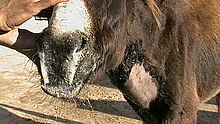Choke (horse)
Choke is a condition in horses in which the
The condition is seen in other Equidae like mules and donkeys.
Causes
Chewing: Horses may develop choke if they do not chew their food properly. Therefore, horses with dental problems (e.g. acquired or congenital
Dry Food: Dry foods may cause choke, especially if the horse does not have free access to water, or if the horse has other risk factors linked to choking.[4] While pelleted or cubed feeds in general fall in this category, horse owners sometimes express particular concerns about beet pulp. However, while horses have choked on beet pulp, a university study did not document that beet pulp is a particular problem.[4] It is believed that choke related to beet pulp is linked to the particle size and the horse's aggressive feeding behaviour, rather than the actual feed itself.[5] Research suggests that horses that bolt their feed without sufficient chewing, or who do not have adequate access to water, are far more likely to choke, regardless of the type of feed, compared to horses that eat at a more leisurely rate.[5] The risk of choke associated with any dry feed can be reduced by soaking the ration prior to feeding.[4]
Foreign Objects: Horse may ingest non-edible materials such as pieces of wood. Cribbers may be more prone to this type of choke, if they happen to swallow a piece of wood or other material while cribbing.
Signs of choke

- Difficulty swallowing (horse may try to swallow without success)
- Lack of interest in food
- Coughing
- Extending the neck and head, usually in a downward direction
- Discharge from the nostrils. usually green in color, although it may also be yellow or clear, often looks like vomit
- Increased salivation, saliva drooling from the mouth
- Heart rate may increase slightly, due to the distressof the animal
- Occasionally, a lump on the side of the neck is visible or can be palpated, where the esophagus is blocked. This is normally most obvious on the left.
Diagnosing choke
If a horse is suspected of choke, a veterinarian will often pass a stomach tube down the animal's esophagus to determine if there is a blockage. Failure to access the stomach with the tube indicates a complete obstruction; difficulty passing the tube may represent a stenosis, or narrowing; or a partial obstruction. Radiography and endoscopy are also used in refractory cases.
Treatment

Choking horses should be deprived of food and drink pending
Refractory cases are sometimes anesthetised, with an orotracheal tube placed to prevent further aspiration and to allow for more vigorous lavage. Disruption of the impacted material can sometimes be achieved via endoscopy. If these methods still do not lead to results, the horse may require surgery to remove the material. Some workers have advocated the use of oxytocin in choke, on the grounds that it decreases the esophageal muscular tone.[6] However, this technique is not suitable in pregnant mares, as it may lead to abortion.
Following up
After the material has passed, a veterinarian may try to prevent the onset of aspiration pneumonia by placing the horse on broad-spectrum antibiotics. The animal should be monitored for several days to ensure that it does not develop pneumonia, caused by inhalation of bacteria-rich food material into the lungs.
The material caught in a horse's throat usually causes
Often the horse will only be fed softened food for a few days, allowing the esophagus to heal, before it is allowed to gradually resume its normal diet (e.g. hay and unsoaked grain). Horses with re-occurring chokes may require their diet to be changed.
Prevention
- Always provide water for the horse
- Soak dry foods before feeding to horses prone to choke
- Change feeds gradually
- Discourage the bolting of food: spread out feed, place large, flat stones (large enough so that the horse can not swallow it) or salt blocks in the feed bin so that the horse must slow down, or feed smaller meals more often
- Cut apples, carrots, or other treats into small pieces
- Withhold feed material for one hour following sedation
References
- ^ Mississippi State University, CARES programme
- .
- ^ Ferraro, GL; Wilson WD; Basile T; Meierhenry BJ (April 2006). "Equine Dentistry: It's Not Just Floating Anymore" (PDF). The Horse Report. 24 (2). Centre for Equine Health, UC Davis School of Veterinary Medicine.[permanent dead link]
- ^ a b c d ""Should You Feed Beet Pulp?" Equus magazine, accessed via equisearch.com June 28, 2010". Archived from the original on May 15, 2009. Retrieved June 28, 2010.
- ^ a b c Warren, Lori K. "Horse Feeding Myths and Misconceptions Archived January 25, 2010, at the Wayback Machine" Horse Industry Section, Alberta Agriculture, Food and Rural Development. Web site accessed June 28, 2010
- PMID 10743971.
- RJ Rose; DR Hodgson (2000). Manual of Equine Practice. WB Saunders. pp. 309–312.
- PT Colahan; IG Mayhew; AM Merritt; JN Moore (1999). Manual of Equine Medicine and Surgery. Mosby Ltd. pp. 198–199.
